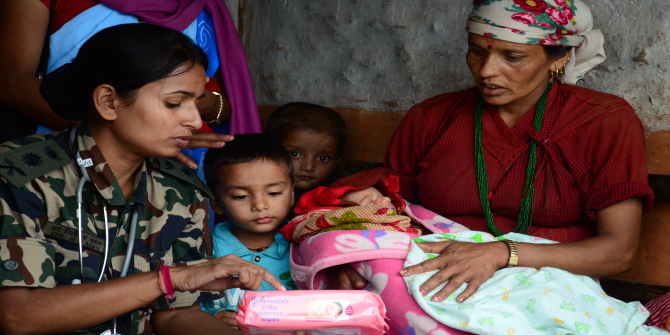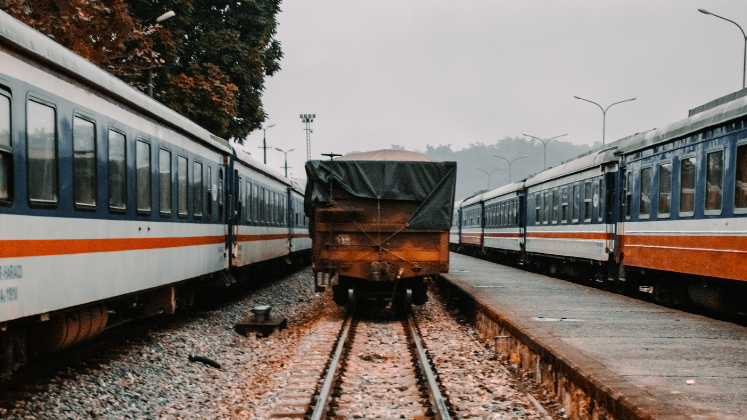In Political Economy of Social Change and Development in Nepal, Jeevan R. Sharma explores how Nepal’s political economy has been transformed since the 1950s. Combining Nepal’s development journey and social change, this book offers a fresh and standout contribution that will be an important guide for social scientists seeking to understand Nepal, finds Sushav Niraula.
Political Economy of Social Change and Development in Nepal. Jeevan R. Sharma. Bloomsbury. 2021.
 Find this book (affiliate link):
Find this book (affiliate link):![]()
In contrast to traditional social science scholarship on Nepal and its isolated focus on identity politics, Political Economy of Social Change and Development in Nepal by Jeevan R. Sharma provides an integrated political economy perspective on Nepal’s social change and development. For this, Sharma situates the book within the broader academic literature surrounding Karl Polyani’s idea of the ‘double movement’. In The Great Transformation: The Political and Economic Origins of Our Time (1944), Polyani theorised that movement from a pre-market to a market-oriented society (the first movement) would lead to a countermovement (the second movement). This countermovement would pressure for social protection against the vulnerabilities brought in by the transition to a market-based economy — mostly livelihood- and ecology-related.
While situating his book within Polyani’s double movement, Sharma bases his arguments on the recent contributions to double movement scholarship. These contributions add that the double movement hypothesis did not consider non-economic injustices (for example, those related to identity exclusion) and countermovements therein. Additionally, they also add that Polyani’s argument was based on nineteenth- and twentieth-century Europe and thereby cannot explain cases in developing states where complex patronage and feudalistic networks make it difficult for economic resistance and reform to follow. Sharma takes Nepal to be one such developing state and shows how it has not seen economic and social protection-related resistance from below but has rather experienced ‘emancipation’-related countermovement; here, the author is referring to identity movements in Nepal.

Photo by Pritush Munankarmi on Unsplash
To make the case for the above hypothesis, Sharma explores cases of social change and development in Nepal since the 1950s — the decade Nepal threw away the autocratic Rana regime and opened itself to the world. Sharma traces how Nepal’s economy has transformed from a land and agriculture-based closed economy to a non-land and remittance-based one that is connected to the global economy. He also shows how this transformation, while opening possibilities for average Nepalis, has also brought in new vulnerabilities, a case in point being the deaths of Nepali migrant workers in the Gulf. This transformation towards an open-market economy follows the first part of Polyani’s hypothesis surrounding the double movement.
Sharma then argues that Nepal has not experienced Polyani-style economic resistance (countermovement, the second part of the double movement) against the new vulnerabilities. Instead, he argues that Nepal has seen identity-related movements that have focused on demands for ‘greater recognition, rights, and representation’ (206). The author is positive about these identity movements, but considers them patchy and limiting as identity exclusion can manifest in different forms. He laments how these movements have failed to raise the economic issue — particularly on the life and livelihood-related vulnerabilities of the previously excluded.
With scholarship on Nepal traditionally limited within the domain of Himalayan studies and identity politics, Sharma’s integrative political economy approach combining Nepal’s development journey and social change remains a fresh and standout contribution. The integrative approach, alongside a detailed exploration of major episodes shaping Nepal’s socio-political-economic journey, makes the book an important guide for social science students seeking to understand Nepal.
I also liked the author’s nuanced takes — in particular, he explores the positives of market-led growth and identity movements but also brings forth their limitations as they fail to consider newer vulnerabilities resulting from Nepal’s transition to a market economy. Consider a Dalit youth who enjoys increased employment prospects and does not face similar forms of identity exclusion to their ancestors. The same youth now has to face greater risks from newer vulnerabilities and forms of exploitation brought in by urbanisation and Nepal’s linkage with the global economy in the form of labour migration — both within Nepal’s urban pockets and the Gulf. These newer vulnerabilities — especially brought by foreign labour migration — currently result in an average of three Nepali deaths per day. In fact, in the preparations leading up to the 2022 World Cup — a symbol of capitalism in good ways and bad — at least 2,100 Nepali labourers have died in Qatar since the country was awarded hosting rights for the World Cup in 2010.
There are two macro points that could have been covered to take the disciplinary scholarship forward and make some of the arguments and claims more convincing. Firstly, the author shows that Nepal did not follow Polyani’s double movement but does not provide detailed arguments for why this was the case. There is a mention of Nepal’s patronage politics as an impediment. But he also mentions India — which is a patronage democracy — having ‘some form of distributive politics in the form of large-scale social protection programmes’ (206). Instead of patronage politics, perhaps India’s long history of democratic rule and social contract explains India’s different trajectory? Or is it other factors? The author could have delved deeper here. I think that Sharma could have engaged with literature surrounding identity formation; this could have supported explanations as to why Nepal has had a salient cleavage and therefore movements surrounding ethnicity rather than class.
Secondly, a rigorous discussion of what qualifies as ‘successful’ resistance is missing. Related to this, I was not clear on whether the author was stating that Nepal has not had any en masse economic resistance in the Polyani sense, that the ones it had were not successful or else that only movements that can ensure a degree of social protection qualify as a countermovement. I am assuming it is the latter, but this could be clarified.
The book remains highly relevant within the present political context wherein populist rhetoric on economic misgovernance and frustration therein is on the rise. This is evident from Nepal’s 2022 general election where a new political party — Rastriya Swatantrata Party (RSP), comprised of technocrats and paradoxically a populist figure as the party chair — tapped into public frustration and surprised established parties with their electoral success. Similarly, Rastriya Prajatantra Party (RPP) — the monarch-supporting Hindu nationalist party which has consistently been against identity movements — has also made electoral headway by raising the economic issue of corruption as their main electoral agenda.
There is a credible danger of progress made by identity movements being framed as an impediment to economic progress by new and old political opportunists; there is also a risk that this will gain traction among disenchanted Nepalis. This has already begun in some form. In this context, the challenge for a more mature Nepali leadership will be to consolidate and safeguard the progress of earlier identity movements and simultaneously address life and lifelihood-related grievances — the very issue highlighted by Sharma.
Note: This review gives the views of the author, and not the position of the LSE Review of Books blog, or of the London School of Economics and Political Science. The LSE RB blog may receive a small commission if you choose to make a purchase through the above Amazon affiliate link. This is entirely independent of the coverage of the book on LSE Review of Books.






